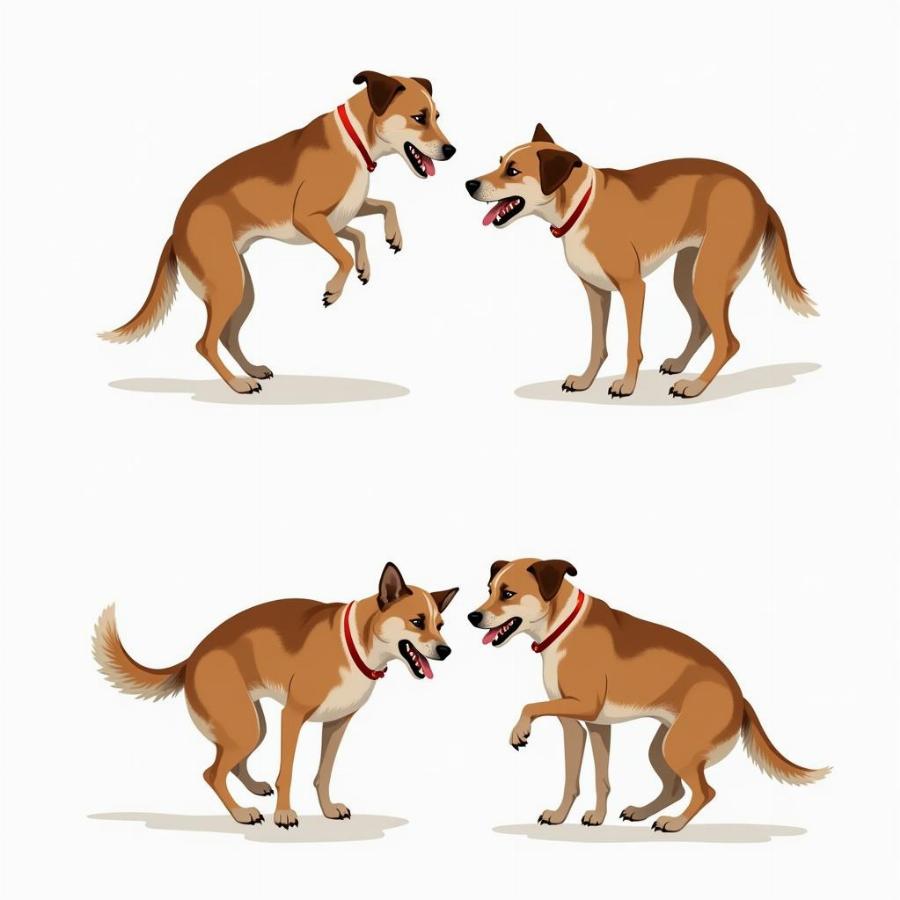Understanding dog behavior can be tricky. Are those snarls and tumbles signs of a playful romp or a serious fight? Knowing the difference between dog play and dog fighting is crucial for any dog owner, ensuring the safety and well-being of your furry friends and others. This article will equip you with the knowledge to accurately interpret canine interactions and intervene appropriately.
Decoding Doggy Body Language: Play vs. Fight
Dog communication is a complex blend of vocalizations and, more importantly, body language. While some signs might seem ambiguous, a closer look reveals distinct differences between playful interactions and aggressive encounters.
Playful Cues: The Joy of Canine Camaraderie
Playful dogs exhibit loose, wiggly body movements. Think bouncy, exaggerated motions. Their mouths might be open, often with a relaxed “play bow” – front legs extended, rear end up in the air. This is a classic invitation to play. Playful vocalizations are usually higher-pitched barks and yips. Even if there’s some growling, it’s typically softer and accompanied by relaxed facial expressions. Importantly, roles often reverse during play – the chaser becomes the chased, the “top dog” momentarily submits. This reciprocity is a key indicator of playful interaction.
Aggressive Signals: Recognizing the Danger Signs
Unlike the fluidity of play, fights are characterized by tense, stiff body postures. Direct stares, bared teeth, and low, guttural growls are serious warning signs. The hair along their backs might stand on end (piloerection). Bites during a fight are meant to inflict harm, often focused on sensitive areas like the face, neck, and belly. Unlike playful wrestling, there’s no role reversal. One dog is clearly trying to dominate the other.
 Dogs Playing vs. Fighting: Understanding Canine Body Language
Dogs Playing vs. Fighting: Understanding Canine Body Language
Is it Rough Play or a Real Fight? Subtle Signs to Watch For
Sometimes, the line between rough play and fighting can blur. Certain breeds naturally play more boisterously. However, even in rough play, there should still be elements of give-and-take. If one dog consistently seems intimidated or distressed, it’s time to intervene. Look for whale eyes (whites of the eyes showing), tucked tails, lip licking, and attempts to escape. These are signs that the “play” has become too much.
What if my dog is always the one starting fights?
If your dog consistently initiates aggressive encounters, it’s crucial to consult with a certified professional dog trainer or a veterinary behaviorist. They can help identify the underlying causes of the aggression, whether it’s fear-based, territorial, or related to resource guarding, and develop a tailored behavior modification plan.
How to Safely Break Up a Dog Fight
Breaking up a dog fight requires caution. Never put your hands directly between the dogs. Try making a loud noise, like banging pots or using a hose. If possible, try to physically separate the dogs by using a large object like a piece of plywood or a blanket to create a barrier. Once separated, keep the dogs apart and monitor them closely.
What should I do after a dog fight?
After a dog fight, check both dogs for injuries. Even seemingly minor wounds can become infected. If either dog is seriously injured, seek immediate veterinary attention. It’s also wise to consult with a professional trainer or behaviorist to prevent future incidents.
Preventing Dog Fights: Proactive Strategies for a Peaceful Pack
Creating a safe and harmonious environment for your dogs involves proactive management. Ensure each dog has its own space and resources, like food bowls and toys. Supervise interactions, especially when introducing new dogs or during high-arousal activities like mealtimes. Early socialization is key to teaching puppies appropriate play behavior. aggressive dog board and train can also be a helpful resource.
Conclusion: Understanding the Nuances of Canine Communication
Recognizing the difference between dog play and fighting is essential for responsible dog ownership. By learning to interpret canine body language and understanding the subtle cues, you can ensure the safety and well-being of your furry companions. Remember, if you’re ever unsure about an interaction, err on the side of caution and intervene. This knowledge will empower you to foster positive relationships within your canine pack and prevent potentially dangerous situations. For more information on dog behavior, you can explore our article on dog stares at me.
FAQ: Common Questions About Dog Play and Fighting
- Do dogs always growl when they’re fighting? Not always. Sometimes, a fight can escalate quickly and silently.
- Is it normal for dogs to play rough? Some level of rough play is normal, but it should always be reciprocal and involve breaks.
- What if my dog gets injured during play? Monitor the injury closely. If it seems serious, consult a veterinarian.
- How can I prevent my dog from starting fights? Early socialization, training, and managing resources can help prevent fights. Also, understanding why a pitbull nanny dog was once so popular can give you insights into responsible dog ownership.
- Should I punish my dog after a fight? Punishment is rarely effective and can worsen aggression. Focus on prevention and behavior modification.
- Can dogs play with different-sized dogs safely? Yes, but supervision is crucial, especially with significant size differences. You might want to explore what happens when you enter a room. 2 dogs are already interacting.
- Are there any resources for learning more about dog behavior? Absolutely! Reading books, attending workshops, or consulting with a certified dog trainer can provide valuable insights. If you’re interested in canine behavior in a different context, you might enjoy learning about the curious incident of the dog in the nighttime play.
Beaut Dogs is your trusted source for all things canine, providing reliable and in-depth information on dog breeds, care, and behavior. When you need expert advice, reach out to us at Email: [email protected] for detailed and accurate answers. Visit Beaut Dogs for more resources and connect with our community of passionate dog lovers.